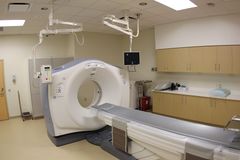CT Scans: Difference between revisions
No edit summary |
No edit summary |
||
| Line 23: | Line 23: | ||
CT produces a volume of data which can be manipulated, through a process known as "windowing", in order to demonstrate various bodily structures based on their ability to block the X-ray/Röntgen beam. Although historically the images generated were in the axial or transverse plane, orthogonal to the long axis of the body, modern scanners allow this volume of data to be reformatted in various planes or even as volumetric (3D) representations of structures. | CT produces a volume of data which can be manipulated, through a process known as "windowing", in order to demonstrate various bodily structures based on their ability to block the X-ray/Röntgen beam. Although historically the images generated were in the axial or transverse plane, orthogonal to the long axis of the body, modern scanners allow this volume of data to be reformatted in various planes or even as volumetric (3D) representations of structures. | ||
Sometimes, CT involves the use of a contrast (imaging) agent, or “dye.” The dye may be given by mouth, injected into a vein, given by enema, or given in all three ways before the procedure. The contrast dye highlights specific areas inside the body, resulting in clearer pictures. Iodine and barium are two dyes commonly used in CT<ref name=":0" /> | |||
== Evidence == | == Evidence == | ||
Revision as of 23:21, 30 April 2019
Top Contributors - Samuel Adedigba, Mande Jooste, Lucinda hampton, Admin, Rachael Lowe, Naomi O'Reilly, Karen Wilson and Kim Jackson
Computed Tomography[edit | edit source]
Computed tomography (CT) is an imaging procedure that uses special x-ray equipment to create detailed pictures, or scans, of areas inside the body. It is also called computerized tomography and computerized axial tomography (CAT).[1] The word "tomography" is derived from the Greek tomos (slice) and graphein (to write).Digital geometry processing is used to generate a three-dimensional image of the inside of an object from a large series of two-dimensional X-ray images taken around a single axis of rotation. Computed tomography was originally known as the "EMI scan" as it was developed at a research branch of EMI, a company best known today for its music and recording business. It was later known as computed axial tomography (CAT or CT scan) and body section röntgenography.
The cross-sectional images generated during a CT scan can be reformatted in multiple planes, and can even generate three-dimensional images which can be viewed on a computer monitor, printed on film or transferred to electronic media.[2]
Although most common in medicine, CT is also used in other fields, such as nondestructive materials testing. Another example is the DigiMorph project at the University of Texas at Austin which uses a CT scanner to study biological and paleontological specimens.
Purpose[edit | edit source]
CT-scans provide detailed cross-sectional images of various internal structures for example internal organs, blood vessels, bones, soft tissue etc, and can be used for:
- Diagnostic purposes-
- Guidance for specific treatment or further tests- surgeries, biopsies and radiation therapy
- Detection and monitoring of conditions- Cancer, heart disease, lung nodules, liver masses
Technique[edit | edit source]
Most modern CT machines take continuous pictures in a helical (or spiral) fashion rather than taking a series of pictures of individual slices of the body, as the original CT machines did. Helical CT has several advantages over older CT techniques: it is faster, produces better 3-D pictures of areas inside the body, and may detect small abnormalities better. The newest CT scanners, called multislice CT or multidetector CT scanners, allow more slices to be imaged in a shorter period of time.[1]
CT produces a volume of data which can be manipulated, through a process known as "windowing", in order to demonstrate various bodily structures based on their ability to block the X-ray/Röntgen beam. Although historically the images generated were in the axial or transverse plane, orthogonal to the long axis of the body, modern scanners allow this volume of data to be reformatted in various planes or even as volumetric (3D) representations of structures.
Sometimes, CT involves the use of a contrast (imaging) agent, or “dye.” The dye may be given by mouth, injected into a vein, given by enema, or given in all three ways before the procedure. The contrast dye highlights specific areas inside the body, resulting in clearer pictures. Iodine and barium are two dyes commonly used in CT[1]
Evidence[edit | edit source]
Provide the evidence for this technique here
Resources[edit | edit source]
add any relevant resources here
References[edit | edit source]
- ↑ 1.0 1.1 1.2 National Cancer Institute. Computed Tomography (CT) Scans and Cancer [Internet]. 2013 [cited 30/04/2019]. Available from: https://www.cancer.gov/about-cancer/diagnosis-staging/ct-scans-fact-sheet.
- ↑ Radiologyinfo.org. Computed Tomography [Internet]. 2019 [cited 30/04/2019]. Available from: https://www.radiologyinfo.org/en/submenu.cfm?pg=ctscan







